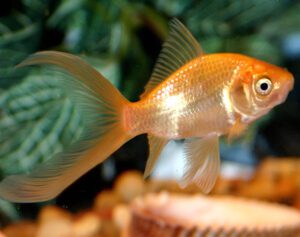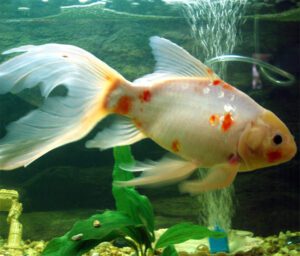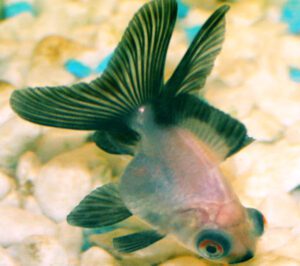The Tosakin goldfish is a very beautiful and distinctive variety of goldfish with a large tail fin that spreads out horizontally behind the fish.
It is also called Curly Fantail Goldfish and was actually developed in Japan. It is believed to have originally developed from the Ryukins.
Currently the fish is mainly available in Japan, and is rarely seen in other countries.
The Tosakin goldfish were first developed by a lower-ranking samurai in the Kochi Prefecture (previously known as Tosa fief), in Shikoku, Japan.
And the variety probably didn’t reach other parts of the country until the mid-twentieth century.
The Tosakin goldfish variety almost went extinct after an Earthquake, but was revived in the mid twentieth century. However, read some more information about this fish species below.
Tosakin Goldfish Characteristics
The Tosakin goldfish have an egg-like, short body. Their body shape is similar to that of other fantailed goldfish varieties.
Tail fins of these fish are open and spread flat and wide horizontally with the leading edges flipping under once or even twice.
They are a weak and even clumsy swimmer, because of their large and broad tail.
The Tosakins have a full dorsal fin, and all other fins are intact too (apart from the major characteristics of that tail).
The inner edges are webbed and the outer lobes upturned and twisted towards the head (making the tail look as if it has been turned inside out).
They are the only goldfish variety to have an undivided double tail. And their tail forms a perfect half-circle when seen from above.
Tosakin goldfish generally come in orange or orange and white coloration. But they are also known to come in black, yellow, calico, red and red and white.

Average body length of the mature Tosakin goldfish is between 4 and 8 inches. Photo and info from Wikipedia.
Diet
Like most other goldfish varieties, the Tosakin goldfish eat almost every kind of fresh, flake or frozen food.
Breeding
The Tosakin goldfish breed well if given proper environmental conditions.
Uses
These fish are used mainly for ornamental purpose. They are beautiful fish and also raised as pets.
Special Notes
The Tosakin goldfish are bred mainly for viewing from above, and much of the effect of the spectacular tail is lost when viewed from the side.
It is the only recognized goldfish variety with an incompletely divided double tail.
They are generally calm and docile creatures that rarely instigate bullying or fighting. Their slow swimming speeds make them a more patient and laid back type of goldfish.
They are especially prone to swim bladder problems, like many other deep-bodied goldfish.
Average lifespan of these fish can vary from 10-15 years. However, review full breed profile of these fish in the following table.
| Name | Tosakin Goldfish |
| Other Names | Also called Curly Fantail Goldfish |
| Breed Purpose | Ornamental, pet |
| Special Notes | Very beautiful, distinctive look, require moderate care, very social fish, friendly and social, bred mainly for viewing from above, is the only recognized goldfish variety with an incompletely divided double tail, calm and docile creatures, slow swimming speeds, prone to swim bladder problems like many other varieties, raised for ornamental purposes |
| Size | Around 4-8 inches |
| Breeding Method | Artificial |
| Climate Tolerance | Native climates |
| Body Color | Common color is orange or orange and white, but also known to come in black, yellow, calico, red and red and white |
| Rarity | Common |
| Availability | Mainly Japan |






